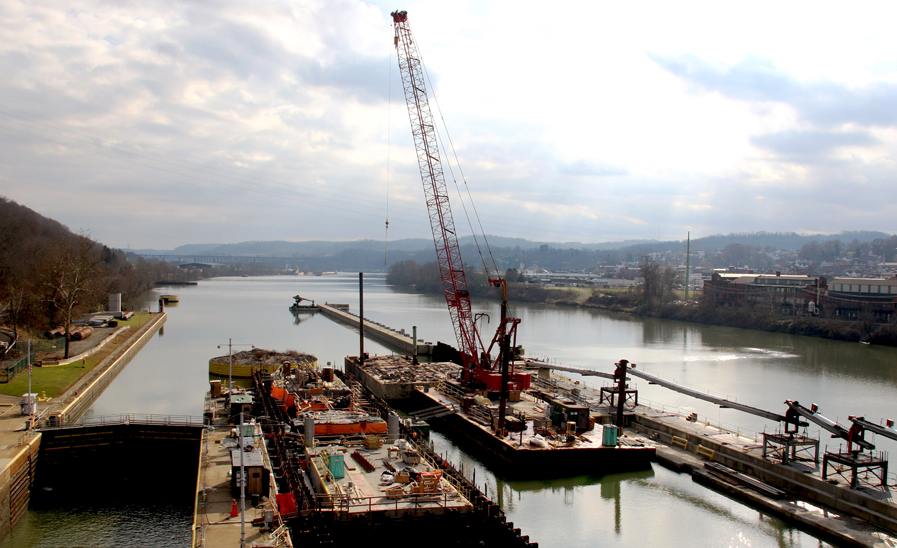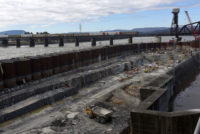Water Infrastructure
Senate Committee Approves 11% Hike for Corps Civil Works

Construction underway at lock on the lower Monongahela River in Pennsylvania. The project, to build two new locks, would receive $111 million under the Senate committee bill, twice the amount President Trump requested. Photo courtesy of U.S. Army Corps of Engineers Pittsburgh District
Senate appropriators have rejected the Trump administration’s proposed drastic cut in the Army Corps of Engineers civil works program for fiscal year 2020, and instead recommended a sizable increase over this year’s funding level. [View bill summary here.]
Along with the unanimous approval of the bill containing Corps spending, the Senate Appropriations Committee in a Sept. 12 voting session also approved overall allocations for each of the 12 individual fiscal 2020 spending bills and cleared the 2020 Dept. of Defense bill, by slender margins, generally along party lines.
Lawmakers are hoping to move at least some of the 12 fiscal 2020 bills before the Oct. 1 start of that fiscal year. But with few legislative days remaining in September, a stopgap continuing resolution is seen as all but inevitable.
In the markup session, the Senate committee’s first for the 2020 bills, Republican lawmakers also narrowly turned back proposals from panel Democrats to reverse President Trump’s recent move to shift funds from military construction projects to pay for building sections of barriers along the U.S.-Mexico border.
In the 2020 appropriations measure for energy and water programs, which passed 31-0, the committee provided $7.75 billion for Corps civil works. That represents an increase of $752 million, or 11%, over the enacted 2019 level. Trump had proposed slashing Corps civil works in 2020 by $2.2 billion, or 31%, to $4.8 billion.
The committee’s $7.75-billion total also exceeds the $7.36 billion for Corps civil works contained in the 2020 spending bill that the House has approved, a figure that itself is about 5% above the 2019 enacted level.
John Doyle, special counsel with law and lobbying firm Jones Walker LLP, says of the Senate panel's recommendations, "The Corps' total civil works number is very, very strong."
Construction, O&M Numbers
Within the Senate committee’s civil works total, the Corps construction account would get $2.18 billion, a 28% boost over 2019 and nearly double the president’s $1.17-billion request. “A fantastic improvement there,” says Doyle, a former senior Army civil works official.
One of the bill's largest construction allocations is $111 million to continue work on two new larger locks at the site of present lock #4 on the lower Monongahela River at Charleroi, Pa. The House-passed bill also would provide $111 million for the project. President Trump requested $55 million.
Operation and maintenance work (O&M) would receive $3.8 billion under the Senate appropriations measure, a modest hike of $59 million, or 2%, compared with 2019’s actual total. The Senate panel's O&M number is 3% below the House’s $3.92 billion but well above the Trump $1.93-billion proposal.
The American Association of Port Authorities also is pleased with the Senate committee's figures, says Jim Walker, AAPA director of navigation policy and legislation. Adding up the bill's 2020 funding for coastal navigation projects, Walker calculates that the total is slightly more than $3 billion, which, he notes, is more than double the Trump administration request and above the House's $2.5 billion.
Walker said via email that the committee's recommended coastal navigation construction funding totals about $1.3 billion, more than double the administration's proposal and a big jump from the House-approved measure's $735 million.
Next Steps
Eventually, a House-Senate conference committee will negotiate the final numbers for Corps civil works and other programs.
Walker says, "We look forward to quick action [on the energy-water bill] by the full Senate and hopefully enactment before the start of the fiscal year, as was done last year."
In the bill’s Dept. of Energy section, DOE defense environmental cleanup funding—which covers the continued remediation of former nuclear weapons plants—would get a hike of $202 million, or 3%, to $6.2 billion.
The next step for the energy-water and DOD appropriations measure would be a Senate floor vote. Majority Leader Mitch McConnell (R-Ky.), a long-time appropriator, indicated at the committee’s voting session that he would like to have a four-bill mini-omnibus package, or minibus, ready for a floor vote. It would include energy-water, defense, labor-health and human services-education and foreign operations.
That would match up with a House-approved minibus containing the same four bills.
But before the Sept. 12 meeting, the Senate committee postponed action on labor-health-education and foreign operations due to problems with controversial policy-related provisions, viewed as “poison pills.”
Mil Con Projects-Border Wall
In the committee meeting, Democrats on the panel also tried unsuccessfully to undo the Trump administration’s recent move to shift $3.6 billion in funds already appropriated for military construction projects to border barrier construction.
The committee’s senior Democrat, Patrick Leahy of Vermont, first proposed changing the allocations, by trimming the defense allotment by $3.6 billion and transferring most of it to the labor-health-education category. But Leahy’s proposal was defeated on a 16-15 party-line vote.
Later, Leahy, this time with Sen. Richard Durbin of Illinois—ranking Democrat on the defense appropriations subcommittee—proposed an amendment barring the administration from using any of the funds in the 2020 DOD bill or the upcoming veterans-military construction spending bill, for building a “wall, fence, border barrier or border security infrastructure.”
Leahy said, “The President has contorted the law beyond all recognition. And he’s undone congressional funding decisions by fiat.”
Committee member Sen. Lindsey Graham (R-S.C.) that he supports Trump's funding transfer. "We're being overrun at the border," Graham says. "I think it is beyond an emergency. I think this a national-security crisis."
But committee Chairman Richard Shelby (R-Ala.) opposed the amendment, saying that the recently enacted budget agreement prohibits changes in funding-transfer authorities. He proposed tabling the proposal and the committee agreed, by a thin margin.




